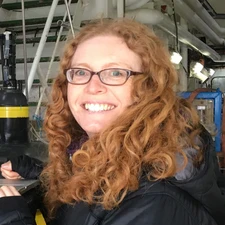Stephanie Henson

The 2024 Fridtjof Nansen Medal is awarded to Stephanie Henson for outstanding research into the ocean’s role in the carbon cycle, built on her extraordinary ability to combine diverse observational data with novel biogeochemical models.
Stephanie Henson has made an outstanding contribution to a topic of fundamental significance to Earth’s carbon cycle: how phytoplankton populations and subsequent carbon fluxes, respond to climate variability and climate change.
Henson’s work has revealed new insights into the long-standing question of the processes driving phytoplankton blooms, through the combination of satellite data, global biogeochemical models and autonomous underwater vehicle data. Recognising that some of the outstanding questions in the field center around how planktonic ecosystems will respond to climate change, Henson designed work to address this, through analysis of both observations and model output. This work has led to new insights into the multiple stressors affecting planktonic communities, and climate change-driven trends. Henson has established an influential body of work examining the observational requirements for distinguishing climate-change driven trends and natural variability in phytoplankton populations. This work challenged the notion that trends in phytoplankton productivity were detectable in the relatively short satellite record, instead identifying the apparent trends as a response to natural variability, and quantifying the length and characteristics of a time series needed to truly identify a climate change trend. These works had a profound impact on the field.
Henson’s work on the magnitude and variability of organic carbon fluxes has challenged existing paradigms from the outset. For example, she developed, on the basis of observational data, a new algorithm to estimate carbon export, which predicted the magnitude of the biological carbon pump to be just half of previous estimates. The insights to be gained by her unique approach of combining observations and modelling were again illustrated when she was able to develop spatially-resolved estimates for the flux of carbon in to the deep ocean on the basis of empirical algorithms. She also was not afraid to challenge her own earlier work; when a later study found a contradictory result, she worked together with the researchers to develop a new paradigm for how remineralisation depth is determined in the twilight zone. This work revealed a seeming paradox in global patterns of biological carbon pump efficiency, which prompted numerous data- and model-based studies to attempt to resolve the discrepancies highlighted by her work.
Henson’s ability for ‘big picture’ thinking and synthesising information from across the field of marine biogeochemistry, resulted in a recent publication that highlighted the uncertainty in model projections of future carbon export and the key knowledge gaps that should be addressed to reduce these uncertainties. Henson’s unique perspective stems from her ability to integrate diverse observational data with model output. This has led to significant advances in both characterising variability and climate change trends in phytoplankton productivity and its drivers, and quantifying the magnitude and variability of carbon export and flux to the deep ocean. Henson’s outstanding scientific contributions are evidenced through her role as a lead author on the latest Intergovernmental Panel on Climate Change (IPCC) Assessment Report on the ‘Carbon and other biogeochemical cycles and feedbacks’ chapter.
